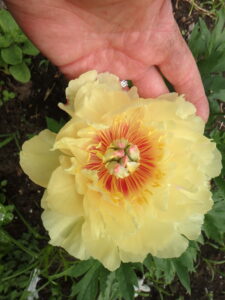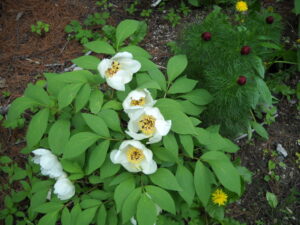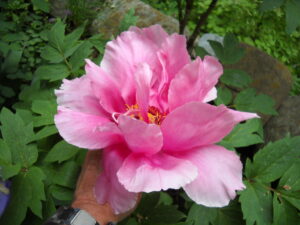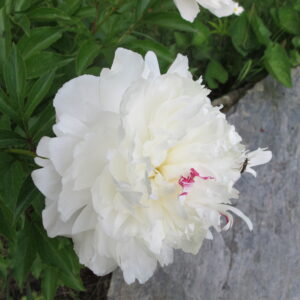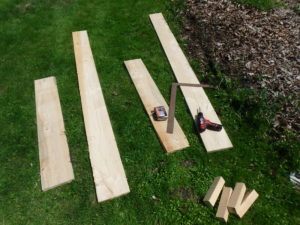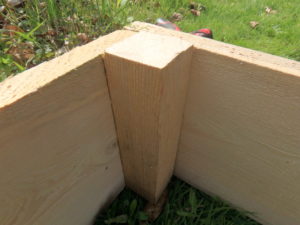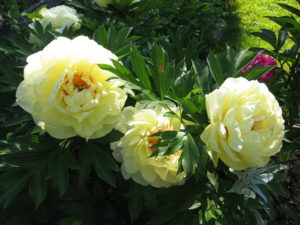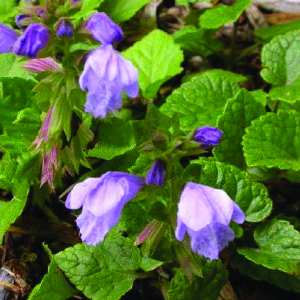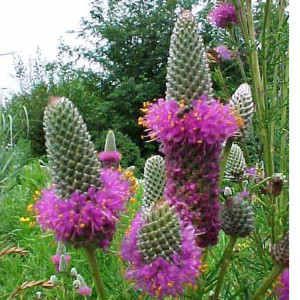Everything You Wanted to Know About Peonies, but Were Afraid to Ask
If you don’t have a peony, I’m surprised. If you don’t have three, you should. They are blooming now, and this is a great time to buy them. Go to your local garden center or family-run plant nursery and buy some more, no matter how many you have. Buying in bloom means you can see the color of the blossoms, and sample the fragrance. Not all are very fragrant, but some are so lovely they might make you swoon.
What is the solution? Buy bamboo stakes that are 3 or 4 feet tall place two to four around each clump of peonies, pushing them deep into the soil. Then encircle the plant with twine, tying the string to each stake with a clove hitch. If you didn’t learn how to tie a clove hitch in the Scouts, U-tube will teach you. The encircling twine should be set about two-thirds the height of the plant. Do this when the buds have not yet opened.
Then there are tree peonies. These are small shrubs that produce huge flowers, up to 8 or 10 inches across. The blossoms are short lived, but spectacular. I had one for 20 years, but it died after a cold winter. Then a few years ago I bought an Itoh peony. This is hybrid of a tree peony crossed with a regular peony. The Itohs generally have yellow blossoms and produce many, many large blossoms over several weeks at maturity. But they are pricey: expect to pay $50 or more for a young plant.
One last bit of advice: Since peonies live so long, be sure to add compost and a little slow-release organic fertilizer at planting time. Then every few years, top dress the soil around your peonies with some fertilizer and compost to get best results.
Tips for Building Raised Beds for Your Garden
As an avid gardener I am always looking for new places to plant. I own a couple of acres of land, but over the past 49 years I’ve filled virtually every square inch of useable space with something – vegetables, flowers, trees and a little lawn. Recently I built a wood-sided raised bed to give me more room for flowers.
Raised beds are good for many reasons:
- The lawn can’t so easily creep into them.
- You can design/blend the soil to be anything you want – sandy, rich or heavy; acidic, neutral or alkaline.
- They drain well, even if built over a soggy base.
- You can place them on the lawn without needing to remove the sod (it will die off).
I built a raised bed recently using rough sawn hemlock I bought from a local sawyer. Rough sawn must means that the wood is cut, but not planed. So a 1”x 8” plank is a full inch thick, not the ¾ inch that you would get at a lumber yard or home center – and hence stronger, and longer lasting.
Hemlock is full or resins that resist rot. It is not as good as cedar, but it is much cheaper. You can buy planed cedar that is a full inch thick, it is called “five-quarter”, and is available at most places that sell lumber. But it’s pricey. You can use plain old pine boards from the lumber yard, but they tend to rot sooner.
Then there is pressure treated wood and synthetic boards made from re-cycled pop bottles that is said to last 50 years or so. Years ago pressure treated wood leached arsenic into the soil, but newer technologies have eliminated that as a problem, I have read. Still, I am personally leery of using it for any food or herbs. I try to avoid chemicals whenever possible.
What size bed should you build? That depends on your space and the reach of your arms. I am relatively tall, so I made my bed 4 feet wide. Smaller people might be more comfortable weeding or planting a bed that is just 3 feet wide. I made mine 8 feet long, but 10 feet or even 6 feet might suit you – or your space – better.
Here’s how I built mine: I cut 2 hemlock boards 8 feet long for the sides, and 2 boards 4 feet long for the ends. Then I cut a piece of wood 2 inches by 2 inches into 8-inch long sections, 4 of them. You can use a 2-by-4 instead of 2 by 2 if you have one.
Instead of using nails I find it easier to work with screws. I used some that were an inch and a half long. Driving screws into dense wood like hemlock or cedar can strain a drill. If you find that the screws don’t easily go all the way in, you can pre-drill holes a little smaller in diameter than the screws. Or you can lubricate the screws by dragging them across a bar of soap (moisten it a little to soften it). That helps a lot.
Those 8-inch pieces of 2 x 2 are for the corners, to make them sturdy, square, and to allow the screws to bite into something more substantial than a 1-inch plank. I screwed them onto the ends of the long planks, then stood up the planks and screwed the short planks into the corner pieces. That is easier to do if you have someone helping you, but you can always lean the long planks against something to keep them vertical if you are working alone.
If you don’t feel handy or don’t have a saw, you can buy brackets that will hold either a 2-inch or 1-inch thick planks. Gardener’s Supply Company sells a variety of brackets designed for 2-inch thick lumber, and Lee Valley Tools has just one type and it is for 1-inch thick lumber (from a lumber yard, so they won’t work on the thicker rough sawn lumber I used). Both companies make nice products, and will ship to your door. Your local lumber yard will cut the boards you need to the length you want. Just ask.
I started this project because I wanted to give perfect soil and sunlight to a new peony I bought from Cider Hill Gardens in Windsor, Vermont. It is one called “Garden Treasure”, an Itoh peony. These peonies are crosses of regular herbaceous peonies with tree peonies.
Itoh peonies can bloom in colors other peonies could not even dream of: yellow with peach, for example. And they can bloom for a full month, producing 50 blossoms or more at maturity. But they are expensive, so I have never gotten one – until this year.
In that same bed I am moving some old daffodils that have stopped blooming. Nearly 50 years ago I dug some old bulbs from my parents’ home in Woodbridge, Connecticut and moved them to my home in New Hampshire. In recent years the leaves have appeared, but not any blossoms.
Those daffodils have been growing in a place that is getting shadier each year and there is more root competition, too. So I will dig them up and move them into this new bed, which offers full sun. I will also treat them to a dose of Bulb Booster to enrich their soil. What I do to pamper my plants!
Reach Henry at henry.homeyer@comcast.net or P.O. Box 364, Cornish Flat, NH 03746. Please include a SASE if wishing a response by mail.
Plans for the New Year
I wonder why it is that so many of us make resolutions at this time of year: lose weight, keep a clean desk, be nicer to people working for political candidates that call us during dinner time … and so on. As a gardener, I don’t tend to think so much about resolutions, but more about what I hope to do in my gardens, come spring. What plants shall I try? What new gardens might I develop?
I recently got a catalog from a wholesale plant nursery, Van Berkum’s of Deerfield, NH, and spent an evening drooling over their catalog and thinking about all the plants I wanted. I made three kinds of notations: a star for everything I simply must have, a check for everything I’d like to have, and a dot for everything that sounds interesting. Needless to say, there were way too many marks to buy them all – I just don’t have room. Here are some of the starred plants.
Meehan’s Mint (Meehania cordata). I’ve never seen this, so I’m intrigued. It is for shade or part shade, likes moist soil, and spreads slowly by stolons (roots). It has showy lavender-blue flowers in May-June, and is a native wildflower that comes originally from Appalachia. I know where to plant this: under some old apple trees where my primroses bloom in pinks, whites and magenta. The foliage is just a couple of inches tall, and the blossoms stand 3 to 4 inches above it.
Purple Prairie Clover (Dalea purpurea). Browsing the on-line photos that are not included in Van Berkum’s printed catalog, the photo caught my eye. Nothing like the clovers I know, it stands 24 to 30 inches tall, and has showy cylindrical cones covered with tiny magenta flowers. The blossoms remind me of teasel flowers in that only part of the cone is blooming at any given time. Native to Missouri, it is hardy to Zone 3 (minus 30 degrees) and needs full sun.
White Cloud Calamint (Calamintha nepeta). I’ve seen this and even planted it for one of my gardening clients. I love it, and although it is listed as a Zone 5 plant, the one I planted wintered over last year, even with a cold winter. It forms a globe-shaped plant loaded with tiny white flowers, reminiscent of baby’s breath. I need one (or more)! Full sun, it tolerates dry soil.
‘Miss Manners’ Obedient Plant (Physostegia virginiana). I love obedient plant, but it is not obedient at all. It’s a thug! Tall, with wonderful pink flowers, it is great in a vase. But my goodness, getting it out of my garden was a struggle. But I miss it, and am tempted by this plant which is, allegedly, “not invasive”. Only 18 to 24 inches tall, it has white flowers and loves moist soil, and I have plenty of that. I’ll keep a sharp on it, and it if takes off, yank it!
Geum rivale ‘Flames of Passion’. This is a small perennial that does best in part shade and takes drought. I want it, largely, because it was introduced by one of my gardenheroes, Piet Oudolf. One winter when I was passing though Holland I visited him at his home in the countryside; I loved the fact that he had commissioned someone to carve life-size stone sheep and had them “grazing” around his property.
Piet Oudolf is a garden designer extraordinaire; among his projects is the High Line, a garden a mile and a half long built on an abandoned elevated railway line in New York. I plan to go there this year on my 70th birthday, April 23. Let me know if you want to join me for a garden walk there. It would be great fun to walk it with interested gardening friends – new or old.
Feather Reed Grass, ‘Karl Foerster’. I’ve got to try this tall grass, having heard it lauded by gardening great Bill Noble when I interviewed him recently. It’s his favorite plant. It grows 36 to 60 inches tall in a big clump, and is lovely from early in the season till late. Full sun.
I love delphiniums, but hate staking them up. There is a new group of them, the New Millennium Hybrids, that “shouldn’t need staking” if planted in full sun. I’ll give one or two a try, and see how they do.
Lastly, I absolutely must get an Itoh peony. This is a cross between a tree peony and an herbaceous peony, and at maturity can produce up to 50 blossoms over the course of a month. Expensive, but I’ve decided it‘s worth it. They come in a variety of colors, and I will buy mine when in bloom, so I will know exactly what I’m getting. I just need to figure out where to plant it. But, hey! I’ve got all winter to do that.
So make your gardening resolutions, or create a wish list for what you hope to plant. You can see photos of the flowers I mention on line at www.vanberkumnursery.com. They are strictly wholesale, but their website has a list of retailers that carry their plants.
Henry Homeyer can be reached at PO Box 364, Cornish Flat, NH 03746 or by e-mail at henry.homeyer@comcast.net.



